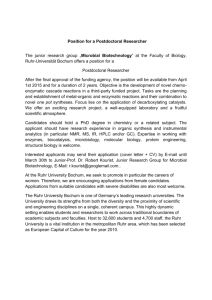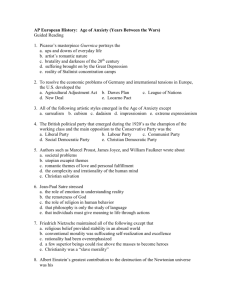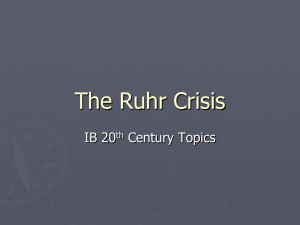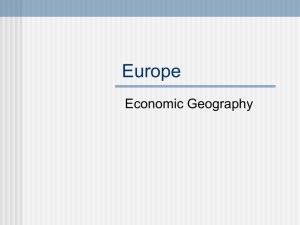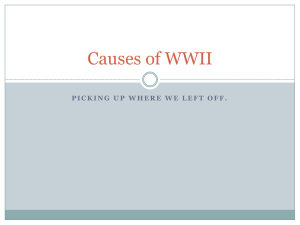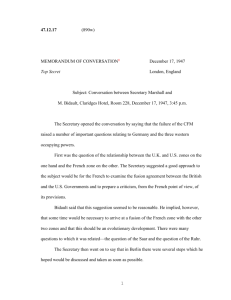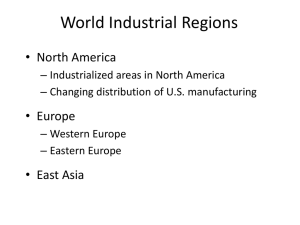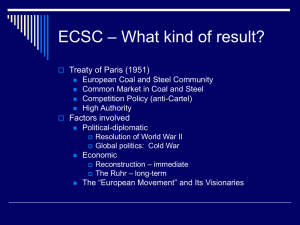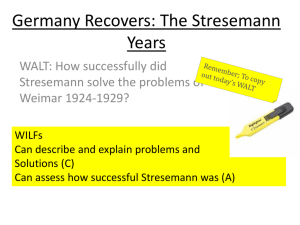Heavy ind - RothesayGeography
advertisement
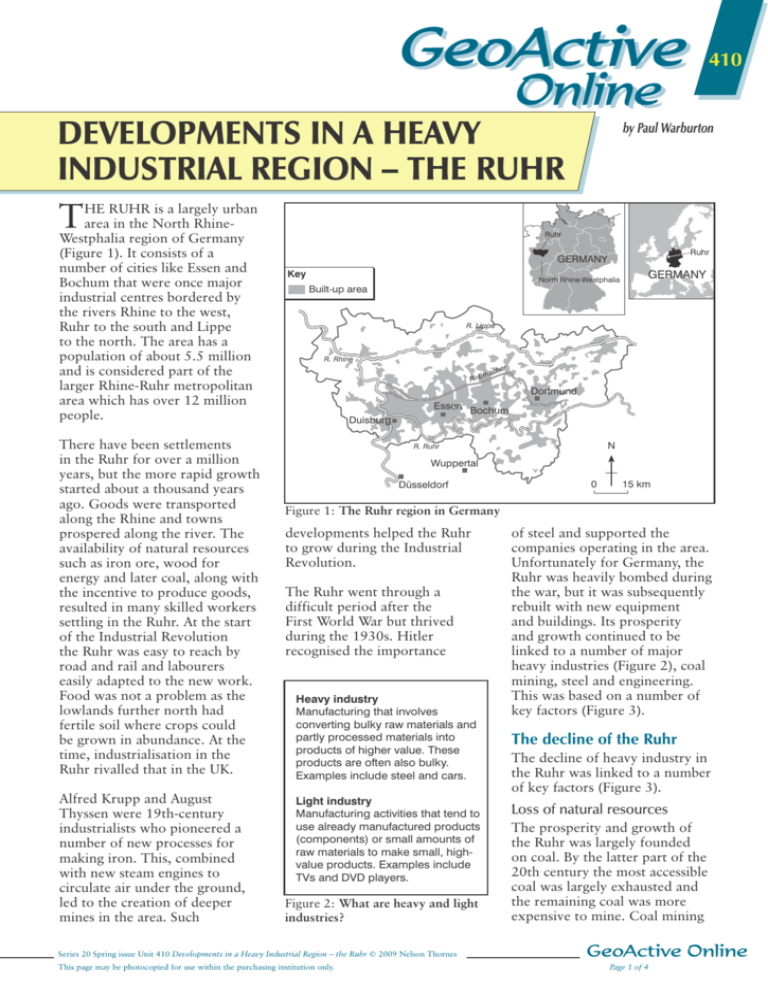
GeoActive Online developments in a heavy industrial region – the ruhr T HE RUHR is a largely urban area in the North RhineWestphalia region of Germany (Figure 1). It consists of a number of cities like Essen and Bochum that were once major industrial centres bordered by the rivers Rhine to the west, Ruhr to the south and Lippe to the north. The area has a population of about 5.5 million and is considered part of the larger Rhine-Ruhr metropolitan area which has over 12 million people. There have been settlements in the Ruhr for over a million years, but the more rapid growth started about a thousand years ago. Goods were transported along the Rhine and towns prospered along the river. The availability of natural resources such as iron ore, wood for energy and later coal, along with the incentive to produce goods, resulted in many skilled workers settling in the Ruhr. At the start of the Industrial Revolution the Ruhr was easy to reach by road and rail and labourers easily adapted to the new work. Food was not a problem as the lowlands further north had fertile soil where crops could be grown in abundance. At the time, industrialisation in the Ruhr rivalled that in the UK. Alfred Krupp and August Thyssen were 19th-century industrialists who pioneered a number of new processes for making iron. This, combined with new steam engines to circulate air under the ground, led to the creation of deeper mines in the area. Such 410 by Paul Warburton Ruhr Ruhr GERMANY Key North Rhine-Westphalia Built-up area GERMANY R. Lippe R. Rhine her msc R. E Dortmund Duisburg Essen Bochum N R. Ruhr Wuppertal 0 Düsseldorf 15 km Figure 1: The Ruhr region in Germany developments helped the Ruhr of steel and supported the to grow during the Industrial companies operating in the area. GeoActive Series 20 Issue 2 Revolution. Unfortunately for Germany, the Fig 410_01 Mac/eps/illustrator 11 s/s NELSON THORNES PUBLISHING Ruhr was heavily bombed during Artist: David Russell Illustration The Ruhr went through a the war, but it was subsequently difficult period after the rebuilt with new equipment First World War but thrived and buildings. Its prosperity during the 1930s. Hitler and growth continued to be recognised the importance linked to a number of major heavy industries (Figure 2), coal mining, steel and engineering. This was based on a number of Heavy industry key factors (Figure 3). Manufacturing that involves converting bulky raw materials and partly processed materials into products of higher value. These products are often also bulky. Examples include steel and cars. Light industry Manufacturing activities that tend to use already manufactured products (components) or small amounts of raw materials to make small, highvalue products. Examples include TVs and DVD players. Figure 2: What are heavy and light industries? The decline of the Ruhr The decline of heavy industry in the Ruhr was linked to a number of key factors (Figure 3). Loss of natural resources The prosperity and growth of the Ruhr was largely founded on coal. By the latter part of the 20th century the most accessible coal was largely exhausted and the remaining coal was more expensive to mine. Coal mining Series 20 Spring issue Unit 410 Developments in a Heavy Industrial Region – the Ruhr © 2009 Nelson Thornes This page may be photocopied for use within the purchasing institution only. GeoActive Online Page 1 of 4 RAW MATERIALS The Ruhr was rich in coal and had other natural resources like iron ore. LABOUR Over a long period a huge and skilled labour force has developed, a valuable resource for the many industries and commercial activities in the Ruhr. KEY FACTORS TRANSPORT The River Rhine runs through the region and provides a link to the North Sea and the world’s shipping lanes. At the mouth of the Rhine is Rotterdam and Europoort, the largest port in Europe and one of the busiest in the world. Canals lead from some of the urban centres to the Rhine. MARKETS About 18 million people live within North Rhine-Westphalia. This represents a huge market. The Ruhr is also centrally placed in Europe, surrounded by economically developed countries with their own huge markets. Figure 3: Key factors in the growth of industry in the Ruhr was also affected by cheaper coal imports from countries like Australia. Although a few mines remain they are progressively being closed. Loss of traditional industries Gradually the major traditional industries in the Ruhr – steel, coal mining, chemical and heavy engineering – started to contract. This was partly related to the loss of cheap natural resources. Increasingly, though, they faced competition from other parts of the world. Industries in newly industrialising countries (NICs) like Malaysia, South Korea and Taiwan were based on cheaper labour and had the latest equipment and technology. They were able to make the same products but at a lower cost. Unemployment As the industries closed, thousands became unemployed, which put off new investment in the region. Between 1980 and 2002, around 500,000 jobs were lost in the traditional industries. Figure 4 shows how this affected one of the largest industrial cities. GeoActive Online Page 2 of 4 90,000 Key 80,000 Breweries Steel Coal mining 70,000 60,000 50,000 40,000 30,000 20,000 10,000 0 1960 1970 1980 Year 1990 1997 Figure 4: Loss of jobs in the old core industries Dortmund, GeoActivein Series 20 Issue 2 Fig 410_04 Mac/eps/illustrator 11 s/s 1960–97 Source: NELSON www.ncl.ac.uk/critical/Dortmund THORNES PUBLISHING Artist: David Russell Illustration Blighted environment The decades of industrial activity and the decline at the end of the 20th century left a devastated environment. The Ruhr had a legacy of derelict buildings, polluted air, rivers and soil. Rebirth of the Ruhr In recent decades the Ruhr has been adapting to change. Efforts have been made to restructure the economy and to tackle the environmental neglect. Tourism The Ruhr may not seem to be the most promising area for tourism. However, after the mining and steel industries fell into decline in the 1970s, the Ruhr Valley decided on an unusual strategy for economic renewal. It turned the dying industrial landscape into a giant history and technology museum, as well as a top recreation destination. This appears to be working. With its mixture of museums, parks and unique historic industrial sites, the Industrial Heritage Route, which officially opened in 1999, helped attract some 3 million visitors to the Ruhr Valley in 2001, with the numbers on the rise, according to tourism authorities. In terms of specific attractions, one of the most popular is the German Mining Museum in Bochum (Figure 5). Founded in 1930, it gives visitors an insight into the world of coal mining. Beneath a 70 metre tower are 25 exhibition halls. A display mine reaches 20 metres below ground, showing curious visitors what life might have been like for a miner. Even more impressive diversification has taken place at the landscape park in DuisburgNord, a former ironworks with towers, gasometers (huge cylindrical containers for storing gas), bunkers, power plants and compressor rooms, all on an immense scale. Since its closure in 1985, parts of the ironworks have been redeveloped – the gasometer has been filled with water to create the biggest artificial diving centre in Europe, the concrete bunkers have been turned into climbing walls, number 5 furnace is dedicated to mountaineers, and an open-air cinema with a rolling roof has been inserted into furnace number 1. The compressor room is regularly booked up for dinners and dances, and the giant power station hosts opera and trade fairs. When darkness falls the Series 20 Spring issue Unit 410 Developments in a Heavy Industrial Region – the Ruhr © 2009 Nelson Thornes This page may be photocopied for use within the purchasing institution only. The highlight is hidden 20 metres below ground level: a replica of a coal mine, with seams, galleries and shafts, complete with all the machinery. The whole stretch is 2.5 km long. Here visitors can see live, close-up demonstrations of various mining techniques. The equipment ranges from a mallet and gad to a fully automatic disc shearer. But the museum is not content with machines, however spectacular they might be. For the history of mining is simultaneously the history of generations of miners, their living and working conditions, life between colliery and carrier pigeons, strikes and settlements, the decline of the coal industry and structural transformation. All these themes are reflected in a huge number of everyday objects, models, diagrams and photographs, painting and statues. At the end of the tour visitors can take a trip to the 60 metre viewing platform at the top of the pithead gear. Figure 5: The German Mining Museum whole tangled mass turns into a light installation, thanks to British lighting designer Jonathan Park (enter ‘Duisburg Nord landscape park’ into Google and look at the images). Changes to industry There has also been rapid growth of a number of major industries including car manufacturing, oil refining and food processing. The region has recognised the expertise and experience associated with the traditional mining, engineering and energyrelated industries and has been adapting to change. It has become the world’s leading location for suppliers to wind power plants, thanks largely to diversification by companies involved in the mining and steel industries. Bio energy is another field where numerous companies have their origins in the mining sector. Many new activities relate to processing and using energy from biomass. Others have emerged working on fuel cells and new hydrogen technology. Two companies of international importance are working in the nuclear industry. These activities range from university research to the development of components to trial and testing. Other business clusters are developing in the geothermal, solar energy, energy-saving technologies and energy services fields, with a special focus on IT systems and services. There are a number of science parks in the region with research and hightechnology companies. These reflect an increasing emphasis on lighter industrial activities (see Figure 2) in contrast to the traditional emphasis on heavy manufacturing. Restructuring the economy of the Ruhr has not been easy. The car industry, for example, has been affected by rising labour costs. Workers in that industry were traditionally paid very high wages but this has put a strain on the competitiveness of the car companies. Thousands of jobs have now gone to Eastern Europe and countries like Turkey where wages are lower. Conclusions The Ruhr has much in common with other traditional industrial areas in Europe. There is still a legacy from its industrial past, some abandoned industrial areas need to be redeveloped and not all economic structures in the region are trend-setting. There are still problems with the infrastructure in the region, such as in the transportation system. Unemployment is one of the major problems in areas that have experienced deindustrialisation and this is still above the average for Germany. There have been notable successes, though, and the Ruhr is remoulding itself to meet the demands of the 21st century. It will probably be several decades yet before the new industries and tertiary activities have a significant effect on employment in the region. The tertiary sector Much of the recent development has been in the tertiary sector. Many traditional industrial towns and cities have attracted new office developments. There has been expansion in fields like research and development, the media and communications. The Ruhr region has one of the biggest concentrations of universities and higher education establishments in Europe. A number of towns and cities have become important centres for retailing and cultural activities. Oberhausen, in the west of the Ruhr, illustrates well the changes that have occurred in a number of towns and cities in the region (Activity 3 will help you to explore these changes). Series 20 Spring issue Unit 410 Developments in a Heavy Industrial Region – the Ruhr © 2009 Nelson Thornes This page may be photocopied for use within the purchasing institution only. GeoActive Online Page 3 of 4 Activities 1 Using an atlas, draw a large outline map of Germany. (a) Add the names of surrounding countries. (b) Add the names of the two seas. (c) Draw on the River Rhine. Region Rate (%) Dortmund 14.6 Ruhr Region 12.0 North RhineWestphalia (NRW) 9.7 NRW without Ruhr region 8.8 Germany (West) 8.0 Germany 2 There are a number of important terms used in this unit – you could be asked to define them in an examination. Define the following: (a) deindustrialisation (b) newly industrialising country (c) infrastructure (d) science park (e) secondary sector (f) tertiary sector. 3 Explain in your own words why the Ruhr region declined. 4 (a) Use a computer program to present the data in Figure 7 as a proportional bar graph. (b) Describe and explain what your completed graph shows. Economy (producing, transporting, using goods) perhaps for a TV programme like Newsround, or as a PowerPoint presentation. 6 Complete the table in Figure 8 to summarise how the changes in the Ruhr have benefited the region. 10.0 Figure 7: Unemployment rate of Dortmund and other parts of Germany, October 2003 Source: www.ncl.ac.uk/critical/Dortmund 5 Use the following website to discover how one large town has successfully changed its image and restructured its economy following the decline of the traditional industries. http://business.metropoleruhr. de/en/information_advice/ site_information/city_town_and_ area_profiles/oberhausen.html There are various ways in which you could present this, for example as a written report, Environment (the world around us – landscape, wildlife, vegetation) Social (relating to people – their health and well-being) Cultural (the features of a society – music, art, literature etc.) Figure 8: Changes in the Ruhr GeoActive Online Page 4 of 4 Series 20 Spring issue Unit 410 Developments in a Heavy Industrial Region – the Ruhr © 2009 Nelson Thornes This page may be photocopied for use within the purchasing institution only.
